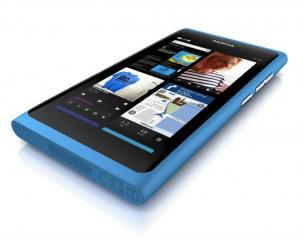Nokia Introduces Its Second NFC-enabled Smartphone

Nokia has introduced its second NFC-enabled smartphone, the N9, which enables users to share photos, videos and music by tapping devices together.
The high-end phone, introduced today in Singapore, is Nokia’s first NFC device supporting the MeeGo operating system. It continues the Finnish handset maker’s push for what it calls “open NFC”–applications that don’t require a secure element.
A Nokia spokesman confirmed to NFC Times that the phone does not support card emulation or a secure element. Nokia said in its press announcement that the device enables users to “easily share images and videos between devices by touching them together.
“Pair it with Bluetooth accessories like the new NFC-enabled Nokia Play 360° wireless music speaker only once, and you get a great surround sound music experience with just a tap,” said Nokia in a statement.
Nokia’s first NFC-enabled smartphone, the C7, a Symbian device, also does not support card emulation and does not have a secure embedded chip or support for SIM-based applications. Nokia enabled the phone for tag reading and P2P applications in April.
Among other applications, the N9 is expected to support the NFC version of the Angry Birds video game, dubbed Angry Birds “Magic,” which allows users to advance to additional levels of the game by tapping their NFC phones to NFC phones of their friends. The C7 supports the game as part of a Nokia-funded tie-in with Angry Birds maker Rovio.
The N9 features Nokia’s new screen design, which dispenses with a home key button. Users swipe their finger across the edge of the 3.9-inch AMOLED screen to return to the home screen. MeeGo, an open-source operating system that, like Symbian, supports Nokia’s Ovi apps, is part of the phone maker’s joint project with chip maker Intel.
In April, Nokia’s vice president for industry collaborations, Mark Selby, speaking at the WIMA NFC conference in Monaco, contended that NFC applications not securely stored on SIM cards, embedded chips or other secure elements will account for two-thirds of the revenue that NFC technology will generate through 2013. He did not release actual figures for the internal market estimates.
These “open” NFC services use tag-reading or peer-to-peer communication features on NFC phones, such those involving consumers tapping their phones on smart posters to download coupons or on packages to receive product information. Or they would tap tags to check in on social networking sites. The services also could include payment and ticketing using the NFC tag-reading or P2P modes, with security not on a secure chip but based in the cloud, said Selby.
Most payment and ticketing applications will be stored on secure chips, however, and Selby added in April that Nokia would also support them in future NFC phones.
“I’m not saying secure (element-based) NFC is bad,” said Selby. “(Just) do not focus exclusively on that area because it is the smaller (opportunity). Whether I’m talking about Groupon, Foursquare or Facebook, there is an extraordinary value, and NFC has a role to play in this.”
Nokia has said it plans to produce several more Symbian phones this year and next, despite its move to the Windows Phone 7 platform. Some of the Symbian phones are expected to support NFC.
As NFC Times has reported, Microsoft plans to incorporate NFC in Windows Phone.












